15-inch Business Laptop Face-Off: ThinkPad T530 vs. Latitude E5530
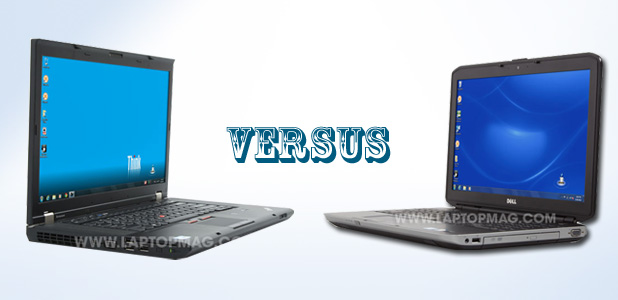
If you're a small business owner or the head of a huge IT department, choosing a new 15-inch notebook for your company can be a difficult decision -- made none the easier when the notebooks you're choosing between feature almost identical hardware. Such is the dilemma facing those choosing between the Lenovo ThinkPad T530 and the Dell Latitude E5530. To make your decision easier, we put the T530 and E5530 head-to-head in a series of ten rounds, comparing everything from the comfort of their keyboards to their battery life. Which business notebook will leave the ring standing?
Round 1: Design
Beauty, as they say, is in the eye of the beholder. If you’re a fan of the ThinkPad series, you’ll love the T530, which boasts the same classic all-black look as previous generations of the ThinkPad. The T530’s chassis is made of reinforced carbon fiber that should help the notebook withstand the abuses of frequent travel. The Dell Latitude E5530 also features a fairly minimalist design, with a magnesium alloy frame, steel hinges and a brushed aluminum lid that picks up fingerprints easily.
In terms of size and weight, however, the ThinkPad T530 clearly comes out on top. Measuring 13.5 x 9.1 x 0.8-1.0 inches and weighing 5.4 pounds, the T530 is thinner and lighter than the Latitude E5530 (15.3 x 9.9 x 1.2-1.3 inches, 6.4 pounds). To be fair, the E5530 we reviewed uses a 9-cell battery (compared to a 6-cell battery on the T530), but we found the Dell’s extra thickness noticeable.
Winner: Lenovo ThinkPad T530 takes this round for its thinner, lighter design.
Round 2: Display
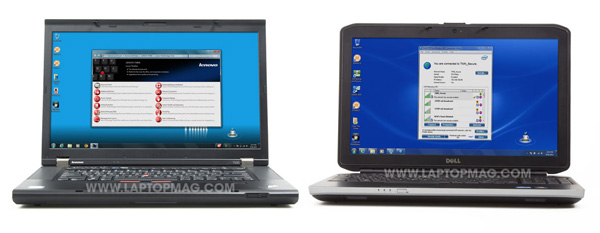
Although the Lenovo ThinkPad T530 starts with a resolution of 1366 x 768 pixels, our configuration ($997) featured a 15.6-inch, 1600 x 900 matte screen. Although it’s fairly dim at 166 lux, the screen boasts vivid colors and excellent viewing angles. For $200 more you can upgrade to full HD 1080p matte display.
Stay in the know with Laptop Mag
Get our in-depth reviews, helpful tips, great deals, and the biggest news stories delivered to your inbox.
The Dell Latitude E5530 also starts with a 1366 x 768 display, which wasn’t upgraded on our $1,178 configuration. You can also upgrade the E5530 with a 1920 x 1080-pixel display, but for $100 less than on the ThinkPad T530. We found the screen on our E5530 review unit to be lackluster, with muted colors and poor viewing angles. However, we don't know how much brighter or more comfortable the E5530 would be with the HD screen option.
Winner: Draw. Both notebooks offer 1080p display options which promise better image quality than the defaults.
Round 3: Audio
Bigger isn’t always better: Although the speakers in the lip of the Latitude E5530 can pump out music at bone-rattling decibels, they sound almost as if they’re underwater when compared to the clarity of sound on the ThinkPad T530. Even more frustratingly, the Dell’s speakers became muffled when we used the notebook on our lap. The ThinkPad's top-mounted speakers, on the other hand, didn’t suffer from this problem.
Winner: Lenovo ThinkPad T530 wins this round because its top-mounted speakers deliver clearer sound.
Round 4: Keyboard and Touchpad

The ThinkPad series has a well-earned reputation for offering comfortable and accurate keyboards, and the T530 is no exception. Its island-style, spill-resistant keyboard proved responsive and offered the perfect amount of tactile feedback. On the Ten Thumbs Typing Test, our reviewer achieved his highest score ever. Though our configuration didn’t come with a backlit keyboard, it’s available as an option.
The 3.1 x 1.8-inch touchpad on the ThinkPad T530 proved equally responsive and comfortable, as did the red TrackPoint pointing stick. Multitouch gestures such as two-finger scrolling and pinch-to-zoom worked flawlessly.
Unlike the T530, the Dell Latitude E5530 opted for a spill-resistant traditional keyboard as well as a dedicated numeric keypad. Although the keys offered a pleasing amount of travel and response, our reviewer found them to be slightly mushy and, as a result, he achieved only an average score on the Ten Thumbs Typing Test. Thankfully, the keyboard features backlighting.
Because of the keypad, the 3.1 x 1.75-inch touchpad is off-center, which could prove annoying for users who want plenty of wrist room on the left side of the deck. The pointing stick between the G and H keys is also a bit too low, making it more difficult to navigate than on the ThinkPad T530. Still, the touchpad proved extremely responsive to gestures.
Winner: ThinkPad T530. Although the Latitude's numeric keypad can be handy for number-crunchers, the E5330's keyboard, pointing stick and touchpad just can't match the ThinkPad's industry leading input devices.
Round 5: Webcam

Unfortunately for customers who use their notebook for video conferencing, neither the ThinkPad T530 nor the Latitude E5530 delivers particularly stellar webcam footage. Both cameras feature a 1280 x 720 resolution and capture brightly colorful video and stills. On each system, however, our reviewers noted distinct graininess, particularly in low-light settings, making fine details difficult to discern.
Winner: Draw. Neither the ThinkPad T530 nor Latitude E5530 boast excellent webcams, making this round a draw.
Round 6: Performance
The Lenovo ThinkPad T530 and Dell Latitude E5530 share remarkably similar hardware: Both notebooks use 2.8-GHz Intel Core i5-3360M processors and 4GB of RAM. The biggest difference is that our T530 review unit had a slightly larger 500GB, 7,200-rpm hard drive, compared to the 320GB, 7,200-rpm hard drive on the E5530.
It’s no surprise, then, that the T530 and E5530 turned in similar scores on our synthetic benchmarks. On PCMark 7, for example, the Dell outscored the Lenovo by a mere 85 points (2,934 compared to 2,845), and completed the LAPTOP Spreadsheet Macro Test (matching 20,000 names and addresses) in 4 minutes and 12 seconds to the T530’s 4:11.
Thanks to its RapidBoot Shield, the ThinkPad T530 gets a leg up on the E5530 in terms of boot time, booting into Windows 7 Professional in 32 seconds, compared to the 58 seconds it took the Dell. The Lenovo also turned in a faster transfer rate than the E5530 (37.4 MBps versus 27.4 MBps).
Winner: Thinkpad T530. Despite having remarkably similar performance, the ThinkPad T530 beats out the Latitude E5530 thanks to its faster boot time and transfer speed.
Round 7: Battery Life
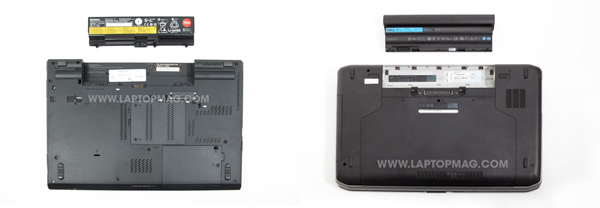
Although our configuration of the ThinkPad T530 came with a 6-cell battery, you have the option of upgrading the laptop with a 9-cell battery for an additional $50 (the 9-cell battery upgrade costs $79 on the Latitude E5530). Head-to-head, the T530 with a 9-cell battery destroyed the Latitude E5530 on the LAPTOP Battery Test (continuous surfing on the Web via Wi-Fi), lasting a herculean 11 hours and 13 minutes, compared to 8 hours and 39 minutes on the E5530.
Winner: ThinkPad T530. With over two hours of additional endurance, Lenovo takes this round easily.
Round 8: Security
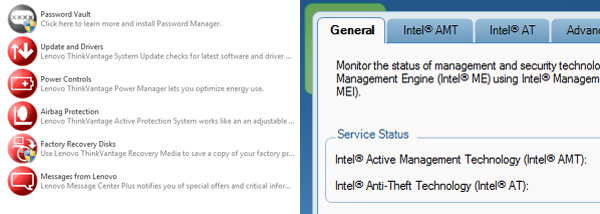
Anyone who travels frequently and uses his or her notebook in a public place can appreciate the importance of good security. Thankfully, the Dell Latitude E5530 comes with a slew of security features, including a fingerprint reader, Intel Anti-Theft Technology that can lock down the notebook remotely if it’s stolen (subscriptions to the service cost $39.99 for one year), and a 30-day trial of Trend Micro Client-Server Security.
Like the E5530, the T530 supports VPro (allowing users to install Intel Anti-Theft Technology). In addition, the notebook offers users the ability to block the use of certain USB devices such as game controllers and portable storage devices. Even better, the ThinkPad T530 comes with a fingerprint reader that remains powered on, even when the notebook is off, allowing you to boot the computer and log in to Windows with just one swipe.
Winner: ThinkPad T530. Although both the Lenovo ThinkPad T530 and Dell Latitude E5530 support Intel Anti-Theft Technology, only the T530 allows you to boot into Windows using the fingerprint reader.
Round 9: Software
The ThinkPad T530 comes preloaded with a bundle of helpful business-centric software. ThinkVantage Tools, for instance, allows users to easily control power management, the webcam, Internet connections, and backup and restore. Even more helpful is Lenovo Solutions for Small Business, which lets you schedule system maintenance and select times when the T530 should automatically turn off or on. Users who store their data in the cloud will also appreciate Lenovo Cloud Storage, Lenovo’s online storage solution that’s powered by SugarSync.
The Latitude E5530 comes with only a handful of preinstalled programs, but those it has are quite helpful. Intel’s Active Management Technology can be used by IT departments to perform remote diagnostic scans, and a free-fall sensor protects the hard drive in the event that the notebook falls from a height of five inches or higher.
Winner: Lenovo ThinkPad T530. Lenovo's ThinkVantage utilities set a high bar that Dell can't meet.
Round 10: Configurations
Although the ThinkPad T530 has a higher starting price than the E5530 ($662 versus $499), the ThinkPad T530 offers much better high-end components. Upgrades include a quad-core Intel Core i7-3820QM CPU, 16GB of RAM, an Nvidia NVS 5400M GPU with 1GB of VRAM, 180GB SSD, 1080p display and a 9-cell battery.
The E5530, by comparison, can only be upgraded to a dual-core Intel Core i7-3520M processor, 8GB of RAM, 128GB SSD, 1080p display and a 9-cell battery – and there’s no option to include discrete graphics. If you’re interested in playing the latest games or editing HD video, the Latitude E5530 won’t get powerful enough for you.
Winner: Lenovo ThinkPad T530 beats out the Latitude E5530 in terms of available configurations.
Verdict
Having swept eight of the ten rounds (with two draws), it’s clear that the Lenovo ThinkPad T530 offers the best value for business users. Not only is the T530 thinner and lighter than the Dell Latitude E5530, it features a more vibrant display, clearer audio, a better keyboard and slightly better performance. Dollar for dollar, business users can’t go wrong with the ThinkPad T530.
Overall Winner: Lenovo ThinkPad T530
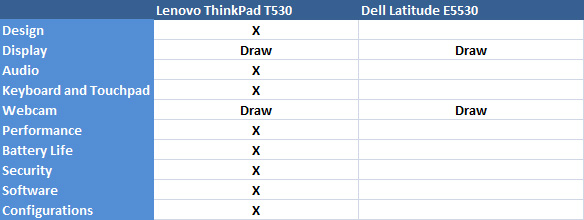
David was a writer at Laptop Mag. His coverage spanned how-to guides, reviews, and product rankings. He reviewed Asus, Lenovo, and Gigabyte laptops; guided readers on how to do various things in Excel, and even how to force quit an app in macOS. Outside of Laptop Mag, his work has appeared on sites such as Tom's Guide and TechRadar.
